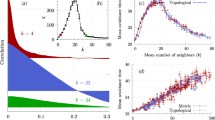Abstract
We focus on the control of heterogeneous swarms of agents that evolve in a random environment. Control is achieved by introducing special agents: leader and infiltrated (shill) agents. A refined distinction is made between hidden and apparent controlling agents. For each case, we provide an analytically solvable example of swarm dynamics.



Similar content being viewed by others
References
Sartoretti G, Hongler MO, Elias de Oliveira M, Mondada F (2014) Decentralized self-selection of swarm trajectories: from dynamical system theory to robotic implementation. Swarm Intell 8(4):329–351
Michini M, Rastgoftar H, Hsieh MA, Jayasuriya S (2014) Distributed formation control for collaborative tracking of manifolds in flows. In: Proceedings of the American Control Conference, pp 3874–3880
Collignon B, Deneubourg JL, Detrain C (2012) Leader-based and self-organized communication: Modelling group-mass recruitment in ants. J Theor Biol 313:7986
Han Jing, Li Ming, Guo Lei (2006) Soft control on collective behavior of a group of autonomous agents by a shill agent. J Syst Sci Complex 19(1):5462
Deneubourg JLH, Bleuler Gribovskiy A, Halloy J, Mondada F (2010) Towards mixed societies of chickens and robots. In: Proceedings of the International Conference on Intelligent Robots and Systems, pp 4722–4728
Krause J, Winfield AFT, Deneubourg J (2011) Interactive robots in experimental biology. Trends Ecol Evol 26(7):369375
Braitenberg V (1984) Vehicles: experiments in synthetic psychology. MIT Press, Cambridge
Krishnanand KN, Ghose D (2005) Formations of minimalist mobile robots using local-templates and spatially distributed interactions. Robot Autonom Syst 53(3–4):194213
Yang T, Mehta PG, Meyn SP (2013) Feedback particle filter. IEEE Trans Autom Control 58(10):2465–2480
Sartoretti G, Hongler MO, Filliger R (2014) The estimation problem and heterogeneous swarms of autonomous agents. In: Proceedings of the Stochastic Modeling Techniques and Data Analysis International Conference
Sartoretti G, Hongler M-O (2013) Soft control of swarms: analytical approach. Proc Int Conf Agents Artif Intell 1:147–153
Banner AI, Karatzas Ichiba T, Papathanakos V, Fernhold R (2011) Hybrid atlas model. Ann Appl Prob 21(2):609–644
Filliger R, Hongler MO, Blanchard P (2006) Soluble models for dynamics driven by a super-diffusive noise. Phys A 370:301–355
Acknowledgments
We thank M.-O. Hongler for numerous discussions in the writing of this paper. The author is funded by the Swiss National Science Foundation.
Author information
Authors and Affiliations
Corresponding author
Additional information
This work was presented in part at the 1st International Symposium on Swarm Behavior and Bio-Inspired Robotics, Kyoto, Japan, October 28–30, 2015.
About this article
Cite this article
Sartoretti, G. Leader-based versus soft control of multi-agent swarms. Artif Life Robotics 21, 302–307 (2016). https://doi.org/10.1007/s10015-016-0274-9
Received:
Accepted:
Published:
Issue Date:
DOI: https://doi.org/10.1007/s10015-016-0274-9




